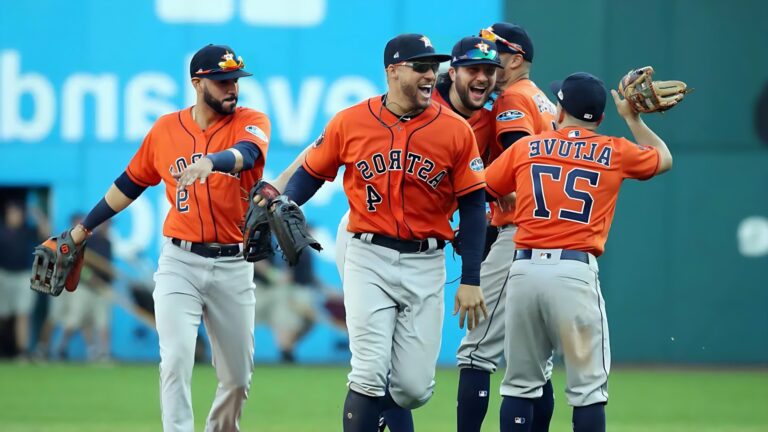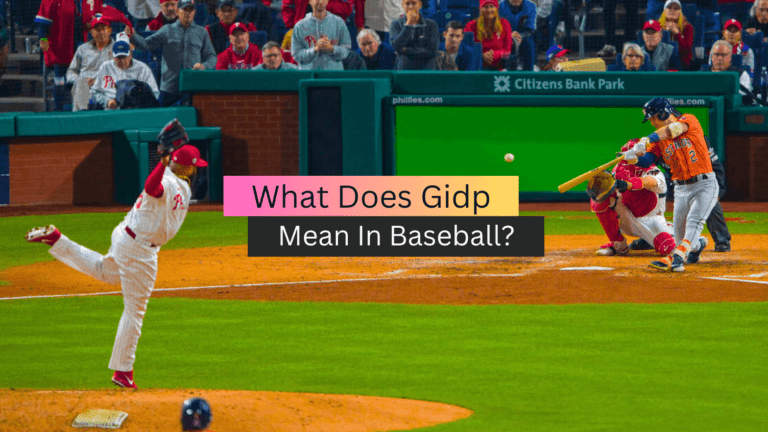What Is OPS In Baseball?
Are you a baseball fan who wants to understand more about the sport’s statistics? If so, you might have come across the term OPS. But what exactly is OPS in baseball, and how does it work?
OPS, or On-base Plus Slugging, is a metric that combines a player’s on-base percentage (OBP) and slugging percentage (SLG) into a single number. The goal of OPS is to measure a player’s overall offensive performance, taking into account both their ability to reach base and their power hitting.
OPS is not only used to evaluate hitters but also pitchers. When used in the context of pitchers, it’s referred to as OPS against, and it helps to evaluate how well a pitcher is preventing batters from reaching base and hitting for power.
If you want to learn more about how OPS works and how it can be used to analyze players’ performance, keep reading our article. We will also explore the history of OPS, its limitations, and how it compares to other metrics in baseball. So, are you ready to dive into the world of OPS in baseball? Let’s get started!
Why is OPS a good start in baseball?
OPS (On-base Plus Slugging) is a popular statistic used in baseball to measure a player’s overall offensive performance. It combines two key components of a player’s offensive game – on-base percentage and slugging percentage – to provide a comprehensive measure of their ability to get on base and hit for power.
OPS has become a preferred metric for evaluating players because it takes into account both the quantity and quality of their offensive contributions, making it a good starting point for assessing their overall effectiveness at the plate.
OPS also provides a more complete picture of a player’s offensive value than either on-base percentage or slugging percentage alone, which can be misleading on their own. As such, OPS is a useful tool for identifying the most productive and valuable offensive players in the game.
What is a good OPS in baseball?
OPS stands for On-Base Plus Slugging, and it is a statistic used to measure a baseball player’s overall offensive performance. A good OPS in baseball depends on the player’s position and league, but generally, an OPS of .800 or higher is considered good, and an OPS of .900 or higher is considered excellent.
However, the average OPS can vary significantly between positions. For example, a catcher or shortstop with an OPS of .750 may be considered good, while a first baseman or outfielder with the same OPS might be considered average.
It’s also important to note that OPS is just one statistic and should not be used as the sole measure of a player’s offensive performance. Other factors, such as on-base percentage, slugging percentage, and batting average, should also be considered when evaluating a player’s overall offensive contribution.
How is OPS calculated in baseball?
OPS stands for On-Base Plus Slugging, and it is a baseball statistic that combines a player’s on-base percentage (OBP) and slugging percentage (SLG) to give a more complete picture of their offensive performance.
To calculate OPS, you add a player’s OBP and SLG together. OBP is the percentage of plate appearances that result in the player reaching base (via hit, walk, or hit by pitch), while SLG is the player’s total bases (singles count as one, doubles count as two, etc.) divided by their total at-bats. So the formula for OPS is:
OPS = OBP + SLG
For example, if a player has an OBP of .400 and an SLG of .500, their OPS would be .900. A higher OPS generally indicates a more productive offensive player, as it takes into account both a player’s ability to get on base and their ability to hit for power. You may read also the guide on the best radar gun for baseball
Criticisms of OPS
OPS (On-Base Plus Slugging) is a widely used statistic in baseball to measure a player’s overall offensive performance. However, it has received its fair share of criticisms from the baseball community.
One major critique of OPS is that it puts too much emphasis on extra-base hits and undervalues on-base percentages. OPS combines a player’s on-base percentage and slugging percentage, giving equal weight to both components. This approach can lead to an overestimation of a player’s value if they have a high slugging percentage but a low on-base percentage.
Another criticism of OPS is that it treats on-base percentage and slugging percentage as equal, even though the slugging percentage is calculated on a 4.000-point scale while the on-base percentage is calculated on a 1.000-point scale. This can lead to misleading comparisons between players with similar OPS but different contributions to their teams.
Finally, OPS has been criticized for its use of mixed fractions, with on-base percentage using plate appearances as a denominator and slugging percentage using at-bats. Adding two fractions with different denominators can be problematic, and OPS does not take into account the different ways in which plate appearances and at-bats are calculated.
Are there better stats than OPS?
OPS (On-base Plus Slugging) is a commonly used statistic in baseball to evaluate a player’s overall offensive performance. It combines a player’s on-base percentage (OBP) and slugging percentage (SLG) into a single number. While OPS is a useful tool for assessing offensive production, there are other statistics that can provide a more complete picture of a player’s performance.
One alternative to OPS is wRC+ (weighted Runs Created Plus), which takes into account a player’s offensive production relative to the league average and adjusts for ballpark factors. This statistic is expressed as an index where 100 represents the league average, and every point above or below 100 represents one percentage point above or below average.
Another advanced metric is wOBA (weighted On-Base Average), which weights each type of offensive event (e.g., single, double, home run) according to its run value and uses that to calculate a player’s overall on-base ability.
Other stats that can provide additional insights into a player’s performance include BABIP (Batting Average on Balls in Play), which measures a player’s ability to get hits when they make contact with the ball, and ISO (Isolated Power), which measures a player’s ability to hit for extra bases. You may read the guide on the can you use a baseball bat for softball
What about OPS+?
OPS+ is a statistic used in baseball to compare a player’s on-base plus slugging percentage (OPS) to the league average, adjusted for the player’s ballpark and era. It is a way to normalize a player’s OPS to account for the differences in offensive environments across different eras and ballparks.
OPS+ is calculated by taking a player’s OPS and dividing it by the league average OPS, then multiplying by 100. A score of 100 is considered average, while a score above 100 indicates an above-average OPS relative to the league, and a score below 100 indicates a below-average OPS.
OPS+ is a useful tool for evaluating a player’s offensive performance relative to his peers, and it is often used in Hall of Fame discussions and player comparisons. However, like any statistical metric, it should be used in conjunction with other factors such as a player’s defensive ability, baserunning skills, and overall impact on the game.
OPS vs. Batting Average: Which is better
OPS (On-Base Plus Slugging) and Batting Average are both metrics used in baseball to evaluate a player’s offensive performance, but they measure different aspects of performance. OPS takes into account both a player’s ability to reach base (on-base percentage) and their ability to hit for power (slugging percentage) while batting average only measures a player’s ability to get a hit per at-bat.
In terms of evaluating a player’s overall offensive performance, OPS is generally considered to be a more useful metric than the batting average. This is because OPS provides a more complete picture of a player’s offensive contributions by considering both their ability to get on base and their ability to hit for extra bases.
What is the highest OPS possible?
OPS (On-base Plus Slugging) is a statistic commonly used in baseball to measure a player’s overall offensive performance. It combines a player’s on-base percentage (OBP) and slugging percentage (SLG) into a single number.
While there is no theoretical limit to how high OPS can be, the practical maximum is 4.000, which would require a player to have a 1.000 OBP and a 3.000 SLG. Such a performance would mean that the player gets on base every time he comes to the plate and hits a home run every time he puts the ball in play.
While achieving such an incredible feat is virtually impossible, there have been a few players who have had OPS numbers over 1.000 for a full season, including Barry Bonds, Babe Ruth, and Ted Williams. OPS is a useful tool for comparing the offensive contributions of different players and can provide valuable insights into a player’s overall performance at the plate.
Is a .600 OPS bad?
In baseball, OPS (On-Base Plus Slugging) is a statistic that combines a player’s on-base percentage (OBP) and slugging percentage (SLG). A .600 OPS is definitely on the lower end of the scale and would generally be considered very poor.
To put it in context, the league average OPS for the 2021 season was .721, which means a player with a .600 OPS would be significantly below average.
An OPS of .700 or higher is generally considered average or better, while an OPS of .900 or higher is considered very good. An OPS of 1.000 or higher is considered elite and is a rare feat in baseball.
It’s worth noting that OPS is not the only statistic used to evaluate a player’s performance, and context is important when interpreting any statistic. For example, a player with a low OPS may still be valuable if they excel defensively or on the basepaths. However, in general, a .600 OPS would not be considered a strong performance. You may check also how long is a baseball game
Conclusion
In conclusion, OPS, or On-base Plus Slugging, is a baseball statistic that combines a player’s on-base percentage (OBP) and slugging percentage (SLG) to provide a more comprehensive measure of a player’s offensive production. OBP measures the rate at which a player reaches base, while SLG measures the player’s ability to hit for extra bases. OPS is a popular statistic among baseball analysts and fans because it provides a more complete picture of a player’s offensive abilities than simply looking at their batting average. A high OPS is generally indicative of a player who is a strong offensive contributor to their team.
FAQs
Who has the highest OPS in baseball?
As of my knowledge cutoff in 2021, the player with the highest OPS in baseball was Shohei Ohtani of the Los Angeles Angels. He had an OPS of 1.001, which was a result of his impressive .965 slugging percentage and .336 on-base percentage.
What is slugging in baseball?
In baseball, “slugging” is a statistic used to measure a player’s power at the plate. It is calculated by dividing a player’s total number of bases by their total number of at-bats. A higher slugging percentage indicates that a player is hitting for more extra bases (doubles, triples, and home runs).
Do Sacrifice Flies Count in OPS?
Yes, sacrifice flies count in OPS (On-Base Plus Slugging) as a factor in the on-base percentage component. A sacrifice fly is counted as an at-bat but does not count against a batter’s on-base percentage, as it is considered a productive out. Therefore, it would be included in the OPS calculation.
Who has the Highest Single Season OPS?
The highest single season OPS (on-base plus slugging percentage) in Major League Baseball (MLB) history is held by Barry Bonds, who achieved a remarkable OPS of 1.422 during the 2004 season while playing for the San Francisco Giants. Bonds set the record by hitting 45 home runs, earning 232 walks, and achieving a .609 on-base percentage and a .812 slugging percentage.








